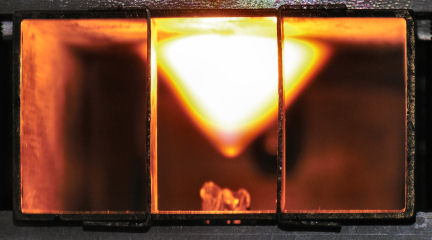Powering ball lightning
A new study might help explain what fuels bouncing balls of fire that occasionally form in nature.
By Emily Sohn
Ball lightning is one of the strangest objects you might never see. The rare, basketball-sized fireballs occasionally form in nature after lightning strikes soil. They can float or bounce and last for several minutes before disappearing.
In recent years, scientists have learned something about the science behind ball lightning. But questions remain. A new study helps illuminate the picture.
 |
|
Researchers unintentionally found a way to make this glowing blob, which may resemble a rare phenomenon in nature called ball lightning.
|
| Eli Jerby |
Researchers at Tel Aviv University in Israel began the study after making ball lightning by mistake in their lab. Vladimir Dikhtyar and Eli Jerby had just invented a new type of drill that was made partly from pieces of microwave ovens.
The tip of the drill concentrates microwave radiation into a spot that measures just 2 millimeters wide. Such concentrated radiation allows the drill to pierce many materials.
About 10 years ago, Dikhtyar and Jerby were testing their new device when a glowing blob suddenly blew out of the material they were drilling. The blob eventually reentered the drill, causing a lot of damage.
Hoping to find out what had ruined their fancy tool, the engineers experimented until they could reliably make fireballs on purpose. The trick, they found, was to drill into glass.
They found a way to cage the glowing blobs for up to several minutes. To make the trap, they used a tissue-box-sized container with glass walls. They kept the glowing orbs alive by zapping them with extra microwaves.
The lab-made blobs were different from ball lightning that occurs in nature. For one thing, the artificial balls were much smaller—just a few centimeters across, instead of basketball-sized or bigger. They formed in a different way too. And if left alone, the manmade blobs vanished within 30 milliseconds. (There are 1,000 milliseconds in 1 second).
Still, the scientists thought their blobs were realistic enough to help test one of the leading theories about what causes ball lightning in nature.
In 2000, researchers from the University of Canterbury in Christchurch, New Zealand, proposed that ball lightning forms when lightning strikes soil. Under the right conditions, the strike creates a charged gas that glows and contains dust that is full of microscopic particles. Chemical reactions within the dust then create energy that keeps the gas glowing, the scientists suspected.
Using an intense X-ray beam, Dikhtyar and Jerby found evidence to support that theory. Their tests showed tiny particles within the artificial blobs. These particles were similar in size to the particles that may exist in natural ball lightning.
Going Deeper:
Castelvecchi, Davide. 2008. Dusty fireball: Can lab-made blob explain ball lightning? Science News 173(Jan. 19):36. Available at http://www.sciencenews.org/articles/20080119/fob3.asp .







